COPYRIGHT, PLEASE NOTE
All the material on this website is copyrighted to J-P Metsavainio, if not otherwise stated. Any content on this website may not be reproduced without the author’s permission.
BUY A MUSEUM QUALITY POSTER
BUY A POSTER:https://astroanarchy.zenfolio.com/
Monday, September 15, 2008
My first ever narrowband color image!

This is a very modest example of three colur narrowband image. But I place it here, since it's my first one. At 11.09. I mainly shoot H-alpha, but before clouds rolled in I managed to capture 4 x 900s O-III and only single shot of S-II, 900s. I will shoot more O-III and S-III when ever weather allows me to do so. In this image the "Hubble paletete" is used where S-II = Red, H-alpha = Green and O-III = Blue
-
NOTE
This image is taken by using QHY8 cooled 6.1mb color camera.
Its not an ideal tool for narrowband imaging.
Each color channel is shooted trough separate filter, this means,
that only 1/4 pixels are used for H-alpha and S-II.
O-III goes mainly to the Green and Blue
pixels of the Bayer matrix array, so about 3/4 of the pixels are used in this case.
How ever, very high quality narrowband images has been taken by using color cameras.
Sunday, September 14, 2008
11.09, the opening image of the season
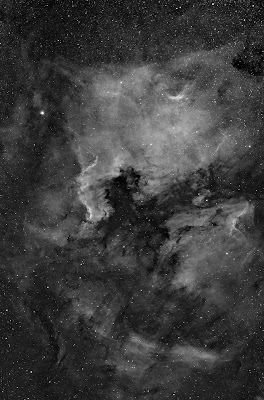
This is a first light for my new equipment, Tokina AT-X 300mm f2.8 manual focus lens.
North America and Pelican nebula shooted @ f2.8 with Baader 7nm H-alpha filter.
I will shoot later S-II and O-III channels to this target (those two filters are new as well)
to create a false color narrowband image.
Even full open, this lens is very sharp and large diameter (112mm) combined to a
fast optics (f2.8) collects photons fast. Exposure time to this relatively deep image was
only 5 x 900s = 1h and 15min.
This fast lens has a very narrow critical focus zone, about 17microns. (17/1000mm !)
I updated my homemade focusing system for this lens to use it with FocusMax software.
Camera: QHY8 (Red pixels only)
Guiding: Lodestar guider and PHD-guiding with LX200 GPS 12"
Exposures: 5 x 900s with Baader 7nm H-alpha filter
Lens: Tokina AT-x 300mm @ f2.8
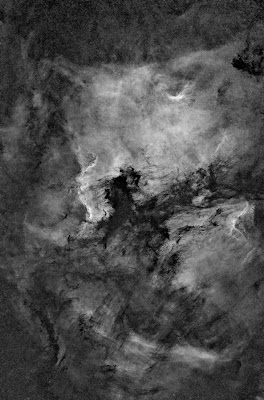

-
NO STARS
-
Here is a same image but all stars are removed.
This way more details are visible in nebula area
and total amount of nebulosity is revealed.
New equipmets and some development work.

System is based on temperature compensating TCF-s focuser and
it's very accurate.
I printed an angular scale and glued it to telescope ring.
The ring is supporting the front end of the heavy lens and same time works
as an indicator to a camera angle.
Labels:
equipments,
research and development
New flat "box" with EL-sheet.
I managed to buy one A2 size sheet of electro luminescent material.
(Here is the link: http://www.posterpoweruk.co.uk/page5.htm )
It works as a perfectly uniform light source and delivers perfect astronomical flats.
I used unexpencive, light weight, plastic frames to protect the light source.
(Not the one with real glas, it's too heavy for the purpose)
As seen in the image, I used two rubber bands with hooks to attach the panel.

In action
Labels:
equipments,
research and development
Angular scale for the AO-system
When OAG (Off Axis Guider) is used, the selection of the guidestar is very important.
Now it's relatively easy to put whole imaging system to an angle readed from
star chart.
The scale is printed to a sticker material and can be seen in upper image.
Labels:
research and development
New Lens for astro imaging
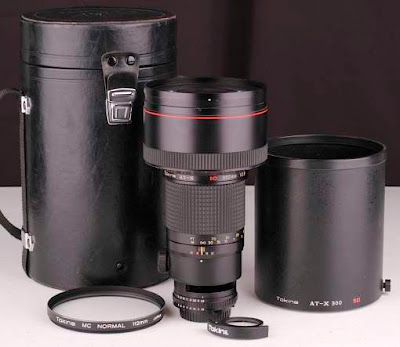
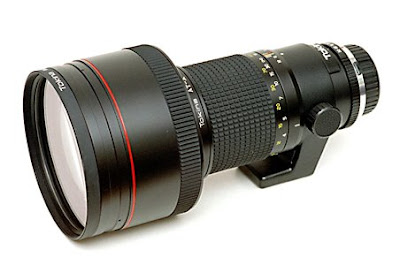
 Tokina AT-X 300 f2.8 is a big and heavy lens.
Tokina AT-X 300 f2.8 is a big and heavy lens.
Diameter of the main lens is 112mm.
Optical quality is very good. At f2.8 stars are absolute pinpoints to very corner of the
imaging area of my APS size camera.
STAR TEST IMAGES, LENS FULL OPEN @ f2.8:
Here is five images from cornes and the center of the image.
Image is just stacked (5 x 900s) and stretched, no other image processing methods are used.

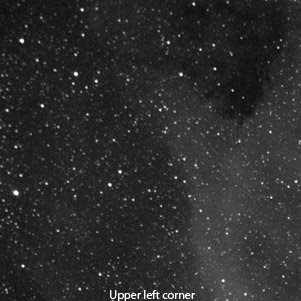
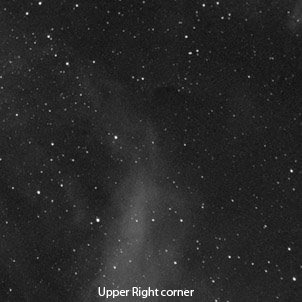
Some brighter stars may have some distortion, but it's cauced by guiding and polar alignment errors.
-
-
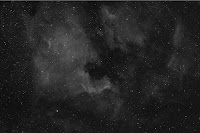 This is a single 900s H-alpha filtered, flat and bias calibrated frame.
This is a single 900s H-alpha filtered, flat and bias calibrated frame.Red pixels only, hence 1/4 size from original frame.
Mildly stretched under CCDStack software due the 8bit format, no other prcessing.
Labels:
equipments,
research and development
Tuesday, July 29, 2008
Comparison of Flame Nebula, with and without stars

This is an example of star removal technique.
Two images of the same target is presented here with and
without stars.
In starless image, the nebulosity is much more visible and some
forms can be seen only in this image.
This can be usefull technique to reweal very faint nebulosity hidden
in overwhelming starfields.
Click for large image.
Labels:
research and development
Thursday, July 17, 2008
Sh2-240 Reprocessed

This was really hard to catch and process.
Somehow better now, I think.
The Sh2-240 (Simeis 147) is a very faint supernova remaint in Taurus.
The image is in false color to show hydrogen alpha emission.Original BW H-alpha image at the bottom
-
IMAGING DETAILS
-Optics:
Canon FD 200mm f2.8 lens with full aperature
- Camera:
QHY8
- Platform and guiding:
LX200 GPS 12" with QHY5 guider and PHD-guiding
- Exposures:
10 x 3600s + 4 x 2700s + 3 x 900s H-alpha + Flats and Bias frames, no darks
exposure time so far 13h 45min.
- Filter:
Baader 7nm H-alp + IDAS LP for RGB

H-alpha
Wednesday, July 16, 2008
Veil Nebula, Western part (reprocessed)

Veil Nebula is a supernova remnant with large angular diameter.
Located about 1400 light years away in the constellation Cygnus.
This is a reprocessed version from Autumn 2007.
ED80 + QHY8, guiding LX200+QHY5, UHC-filter 4h+flats+bias.
-
Eastern part of the Nebula can be seen here:
Subscribe to:
Comments (Atom)














